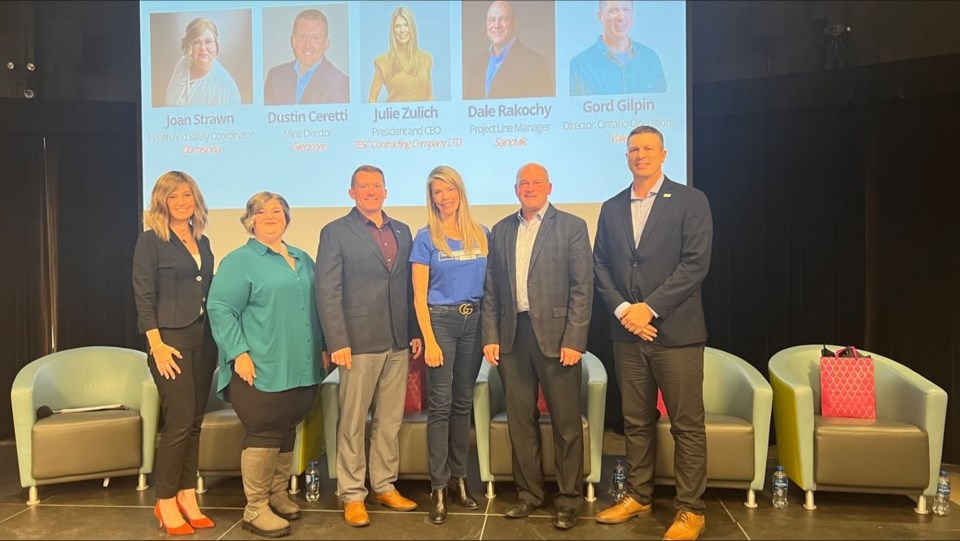In 2019, just nine per cent of Vale’s workforce was represented by women.
Five years on, that number has jumped to 14 per cent, and yet the Sudbury nickel miner is still “nowhere near where we need to go” to achieve gender parity in the workplace, said the company’s director of Ontario operations.
“It is well understood that diverse and inclusive bodies of people who collectively shape and make decisions make better decisions,” said Gord Gilpin during an October 25 panel discussion hosted by Cambrian College. “You cannot lose at all by going in this direction.
“The other fundamental thing is that it’s just absolutely the right thing to be doing.”
Gilpin joined other industry leaders in conversation about how to attract more women to the trades as a precursor to the college’s Jill of All Trades event in Sudbury.
The annual day-long event welcomes girls in Grades 9 to 12 to take part in hands-on workshops showcasing skilled trades programming offered at the school, listen to a keynote address from a speaker in the field, and take a tour of Cambrian and its labs.
As in mining, construction is not well represented by women, who make up just two per cent of workers in labour positions in the industry, according to Joan Strawn, the health and safety co-ordinator at Damisona Roofing.
That’s, in part, because for many years work in the trades has been seen as “less desirable,” she said.
But as word spreads about the range of opportunities available, the trades are becoming a more viable option for women seeking stable, lucrative work.
“We’re seeing that the trades are really well-paying, stable positions,” Strawn said. “A woman in the trades can support her family and have a fulfilling career in the trades and have a secure position.”
Attracting women to the trades is one challenge, but ensuring they feel welcome enough to stay is another.
Construction is a typically “male-populated” industry, noted Julie Zulich, president and CEO at TESC. A lack of representation can be enough to instill fear and uncertainty for women.
Many also question how the erratic nature of work in the sector — lots of travel, working at remote sites, adapting to shift work — will factor into their decision to raise a family, Zulich said.
But the breadth and variety of positions available means that women have a number of opportunities open to them, and trades work could just be a starting point.
“Our paths are not really linear. So a career in trades can turn into project management, construction management, engineering, health and safety, quality,” Zulich said.
“I think there are so many (workers) that are required, and it’s really important for females to hear that message.”
At Glencore, where just 10 per cent of the workforce is represented by women and only 2.5 per cent of that is represented by trades workers, mine director Dustin Ceretti conceded that “we know we have a gap to close.”
Among the initiatives it’s undertaking to change that, the company has set up a women’s working group, which enables Glencore to get feedback directly from its female workers to understand what’s preventing more women from entering the industry.
“That women’s working group is really helping us understand what things we could do differently that lead to inclusivity,” Ceretti said. “We don’t know that unless we ask those questions.”
The company is making some progress. For the first time in Glencore’s history in Sudbury, 25 per cent of the senior leadership team is female. That’s compared to having no women in senior leadership in 2018.
Glencore also supports workers as they advance through the ranks. In the last year, two women who started in the trades have moved up to supervisor positions, which Ceretti called a “testament to women finding their way into the trades, and having that drive.”
“Don’t look at the trades as your career in mining,” he advised, echoing Zulich’s words. “It’s your foothold to get into mining and then the future’s up to you. We have a lot of opportunities.”
But a career in mining starts with education, and Dale Rakochy said that begins at home.
Rakochy, a product line manager with Sandvik, said parents and families need to help educate students about the possibilities trades work offers.
During a recent luncheon he had with a group of tradeswomen from Sandvik, Rakochy said he learned most of the women were second-generation trades workers. They became a heavy duty equipment mechanic or electrician because their parents had worked in that career path.
“The real question is how do we open the eyes of women who don’t have those role models in their life right now to recognize that those are good career choices,” Rakochy said.
He advised parents to keep an open mind about non-traditional work and suggested that getting a university degree isn’t the only way to guide their kids to a long, successful career.
“For parents who aren’t associated with those (trades) fields, don’t dismiss those options because you don’t understand it,” he said. “I think we all have a role to play as educators, as parents to help young people pick a career path.”



